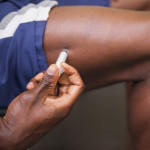 The efficacy of Janssen Therapeutics’ Edurant (rilpivirine) is similar to that of Sustiva (efavirenz) over two years of treatment, according to an analysis of two large clinical trials, but Edurant demonstrated much fewer central nervous system side effects, according to a presentation Tuesday, July 19, at the 6th IAS Conference on HIV Pathogenesis, Treatment and Prevention in Rome.
The efficacy of Janssen Therapeutics’ Edurant (rilpivirine) is similar to that of Sustiva (efavirenz) over two years of treatment, according to an analysis of two large clinical trials, but Edurant demonstrated much fewer central nervous system side effects, according to a presentation Tuesday, July 19, at the 6th IAS Conference on HIV Pathogenesis, Treatment and Prevention in Rome.
Edurant was approved by the U.S. Food and Drug Administration (FDA) in May 2011. Forty-eight week data from two Phase III clinical trials—ECHO and THRIVE—were used to support the drug’s approval application.
Final, long-term follow-up data from the studies, reflecting 96 weeks (nearly two years) of observation, were reported at IAS 2011 by Calvin Cohen, MD, from the Community Research Initiative New England, in Boston.
ECHO was a 690-person study comparing 25 mg of Edurant once-daily plus Truvada (tenofovir plus emtricitabine) with Sustiva plus Truvada for 96 weeks in first-time treatment-takers. The THRIVE study, with 678 participants, had a similar design, but people were able to use Epzicom (abacavir plus lamivudine) or Combivir (zidovudine plus lamivudine) instead of Truvada.
To be enrolled in either study, people had to have a viral load of 5,000 or higher, no resistance to non-nucleoside reverse transcriptase inhibitors (NNRTIs), and full sensitivity to Truvada, Epzicom or Combivir. Characteristics of the participants were similar in both studies, with participants having an average CD4 count of roughly 250 and with about half of the participants having a viral load over 100,000 copies.
Cohen reported that Edurant efficacy was statistically similar in both studies compared with Sustiva. In an analysis where the two studies were pooled together, 77.6 percent of those taking Edurant or Sustiva had a viral load of less than 50 copies at week 96.
Virologic failures—defined as either an inability to reduce viral load to undetectable levels or a rebound in viral load after achieving an undetectable result—were nearly twice as likely among those receiving Edurant compared with Sustiva, occurring in 14 percent and 7.6 percent, respectively. Cohen noted, however, that the difference between the two groups was only notable during the first 48 weeks of treatment; virologic failures generally occurred at the same rate during the second half of the study.
The development of NNRTI-associated resistance mutations occurred equally among those in the two groups—57 percent of those taking Edurant who experienced virologic failure and 54 percent of those taking Sustiva who experienced virologic failure. However, the development of mutations conferring resistance to nucleoside reverse transcriptase inhibitors—notably the M184 mutation known to decrease sensitivity to lamivudine and emtricitabine—was more likely to occur among those who experienced virologic failure while taking Edurant compared with Sustiva (56 percent versus 31 percent, respectively).
Cohen noted that most patients who had NNRTI-associated resistance mutations upon experiencing virologic failure while on Edurant had the E138K mutation, which can hinder the effectiveness of Edurant, a second-line NNRTI option. Encouragingly, no participants developed the K103N mutation, which means that they may benefit from using Sustiva in subsequent regimens.
Among those in the Sustiva group who had NNRTI-associated resistance mutations and who experienced virologic failure, K103N commonly arose, whereas E138K did not.
In terms of tolerability and side effects, Edurant performed much better than Sustiva. In fact, side effects leading to discontinuation of therapy were more than twice as common among those taking Sustiva compared with Edurant (8.5 percent versus 4.1 percent, respectively). And across the board, moderate-to-severe adverse events were twice as likely among Sustiva takers compared with Edurant takers (33 percent versus 17 percent, respectively).
Central nervous system problems, such as abnormal dreams and dizziness, as well as rash, were more likely to occur among those taking Sustiva compared with Edurant.
There was also a trend toward higher rates of moderate-to-severe total cholesterol levels, “bad” LDL cholesterol levels and triglyceride levels among those taking Sustiva compared with Edurant.
Cohen concluded by pointing out the high response rate in both groups and the similarity in efficacy between Edurant and Sustiva, while also acknowledging the higher rate of virologic failures in the Edurant group and the higher rate of treatment-related adverse events in the Sustiva group. He also noted that Janssen continues to work with Gilead Sciences on the development of a single, once-daily pill combining both Edurant and the two active drugs in Truvada.






Comments
Comments